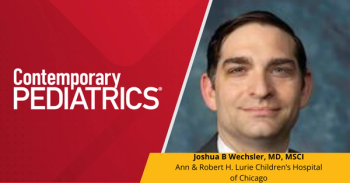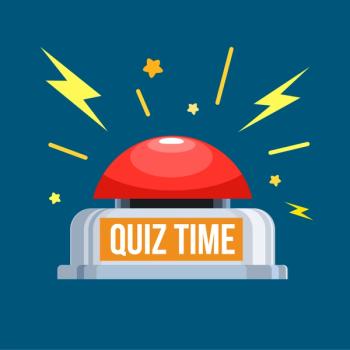
Updates
Using books to sell snacks, Resources for pediatricians, What happened to children's health insurance? Do all children with otitis need antibiotics? Eye on Washington
UPDATES
Using books to sell snacks
Some might call it an unholy alliance: children's book publishers promoting snack food like Pepperidge Farm Goldfish, Froot Loops cereal, and M&Ms as bait to get little kids hooked on reading. The board books representing this union are made with little cutouts where children can insert Froot Loops or M&Ms, to illustrate a counting rhyme or play a game. The pages are coated with plastic, so food smudges can be easily wiped away. According to the New York Times, the best-selling food book (1.2 million copies in the last two years) is called The Cheerios Play Book. Other books in the same genre feature Oreo cookies, Sun-Maid raisins, Hershey Kisses, Skittles, and Necco Sweethearts.
Some children's librarians and parents might find these books a godsend, an inspired way to get a very young child to sit quietly, learn to count, and begin to associate books with pleasure. The American Academy of Pediatrics feels differently. According to Miriam Bar-on, MD, who chairs its public education committee, targeting little kids for this kind of marketing is "revolting" and encourages emotionally unhealthy attitudes toward food as reward rather than nutrition. Pediatricians may want to discourage this trend, but it's likely to be an uphill battle.
Resources for pediatricians
In this age of information overload, pediatricians need all the help they can get to stay ahead of the curve. Here's a list of resources that can help:
FAPE (Families and Advocates Partnership for Education) is a federally funded project created to inform families about the Individuals with Disabilities Education Act of 1977 (more commonly known as IDEA) and how it can help their children. FAPE offers parents technical information on how to benefit from IDEA and referrals to advocacy organizations and parent training and information centers. Parents can reach FAPE by calling 800-248-0822 or on the Web at
El Cuidado de su Hijo Pequeño, a Spanish language edition of the AAP's comprehensive child-care book, Caring for Your Baby and Young Child: Birth to Age 5, is now available from the AAP publications department for $15.95. To order, call 888-227-1770.
Evidence-based practice guidelines for the treatment of Lyme disease are now available from the Infectious Disease Society of America (IDSA), at its Web site:
The newly updated edition of Dietary Guidelines for Americans, 2000 can be obtained from the US Department of Agriculture. The new Guidelines stress physical activity and weight control, emphasize the need for whole-grain foods, and include warnings about food safety. They are available on the Web at
Practice guidelines from the American Academy of Neurology outline screening procedures for autism. The academy recommends autism screening at all routine pediatric visits. The guidelines are available on the Web at
Free and Low Cost Medical Care is a booklet with information on how and where to get care subsidized by the federal Hill-Burton program, which obligates hospitals and other medical care facilities to provide services in exchange for federal construction funds. You can order the booklet, which also includes information on free and low-cost prescription drugs, from the Financial Assistance Network, PO Box 60848, Washington, DC, 20039-0848. Parents can call 202-595-1039 for information or go to the network's Web site,
What happened to children's health insurance?
The last four years have seen some strange ups and downs in health insurance coverage for children. First, in 1996, when Congress passed legislation limiting access to welfare programs, many poor children lost Medicaid coverage when their families left the welfare rolls. And parents moving from welfare to work seldom found jobs that provided health insurance for their dependents.
To provide coverage for those children, Congress passed SCHIP, the State Children's Health Insurance Program, designed to take care of the children of the working poor. In addition, as the burgeoning economy created tight labor markets, more employers started to offer insurance benefits.
Which brings us to the present day, when the Census Bureau announced last month that the number of uninsured children declined to 10 million in 1999, down from 11.1 million the year before. That is to say, the percentage of children without coverage (13.9%) is now back to where it was in 1996.
Why do we still have 10 million children without health insurance? Part of the answer is that SCHIP hasn't fulfilled its potential. In fact, 40 states have failed to spend all the SCHIP funds allocated to them in the program's first year and will have to return the unspent funds to the federal government. The reasons for these failures are complicated: Some states probably were allotted more funds than they needed; some were unwilling to chip in the required proportion of their own money; and, according to studies by the Commonwealth Fund, some created barriers to enrollment with required copays or premiums or didn't make enough of an effort to get the word out to eligible families. Copies of the Commonwealth Fund reports, which include descriptions of successful outreach strategies some states have used, are available without cost by calling the Fund's toll-free publications line, 888-777-2744.
Do all children with otitis need antibiotics?
According to a meta-analysis of clinical studies done during the last 35 years, the answer to that question may be No. The basic finding was that almost two thirds of children with uncomplicated acute otitis media (AOM) recover from pain and fever within 24 hours of diagnosis without antibiotics, a figure that rises to 80% by the end of the first week after diagnosis. For comparison, the review found that 93% of children with AOM who are treated with antibiotics recover during the first week. So the question becomes, is that relatively small difference in outcome sufficient to justify routine antibiotic treatmentespecially in light of increasing antibiotic resistance among the pathogens that cause AOM. Some pediatricians may conclude that an attitude of watchful waiting, the common practice in Europe, is more reasonablealthough they will probably find it difficult to convince parents of a child with ear pain and fever. If you do prescribe antibiotics, a second finding of the study is also significant: There is no evidence to conclude that children with AOM will do any better with the newer, relatively expensive antibiotics than with that old standby, amoxicillin.
The review was conducted by the Southern California/ RAND Evidence-based Practice Center and sponsored by the Agency for Healthcare Research and Quality. It is available on the AHRQ Web site,
EYE ON WASHINGTON
By this time, the endgame is over. We know just how much Republican members of Congress, desperate to adjourn and get out on the hustings, were willing to give up. And we know how cleverly a lame-duck President was able to use the veto threat to make sure at least some of his health-care priorities were achieved in the remaining appropriations bills of the waning session. The new administration's health-care agenda remains to be seen after Inauguration Day.
Yet much of the nation's health-care policy is made outside the halls of Congress, in the administrative agencies. Last month, these actions had an impact on the health of children and families:
The Census Bureau reported growth in income and declines in poverty in 1999, returning the economy to the levels of the early part of the decade. Median household income stood at $40,816 last year, and 11.8% of the population lived below the poverty line (defined as household income of $17,029 for a family of four). The percentage of children living in poverty dropped to 16.9%, the lowest since 1979. Nevertheless, children under 6 years of age are particularly likely to be poor, while those living in families with a female head of household and no husband present have a poverty rate of 50.3%.
The Department of Agriculture issued its annual report on hunger in America, finding that although hunger and what the department calls "food insecurity" are declining in our increasingly prosperous economy, some 31 million people grappled with hunger or the fear of hunger last year. That figure includes about 12 million children, or about 17% of all children. Among households of single mothers with children, nearly 30% were uncertain of having adequate food to meet their basic needs and 8% went hungry in 1999.
The Federal Trade Commission announced plans to subpoena records of pharmaceutical companies, to see whether deals between brand-name and generic drug manufacturers were harming consumers by keeping lower-priced generics from entering the market. The FTC also released a study deploring what it called "pervasive and aggressive marketing" of violent entertainment to children via films, music videos, and video games.
The Supreme Court agreed to hear an appeal of a lower court holding that the Medical University of South Carolina was acting constitutionally when its public hospital in Charleston did drug tests on some of its maternity patients' urine without the women's consent and turned evidence of cocaine use over to the local police. The constitutional question is whether the testing was an unconstitutional search under the Fourth Amendment or a legitimate public health measure taken in the interests of the children born to cocaine-using mothers.
The Food and Drug Administration approved the US marketing of RU-486, the abortion pill regimen developed in France, in late September. Congressional foes of abortion vowed to introduce legislation to derail the FDA decision.
Calendar
January 17-22, Masters of Pediatrics, Miami Beach, FL. To register, call 800-62-CHILD.
February 7-10, International Conference on Learning Disabilities, New York City. For more information, call the Learning Disabilities Association at 888-300-6710 or send e-mail to
February 22-26, Pediatric Anesthesiology Meeting, San Diego, CA. To register, call 804-282-9780.
February 23-27, Pediatric Nephrology Seminar, Miami Beach, FL. To register, call 305-243-6716.
March 1-3, Southern Society for Pediatric Research, New Orleans, LA. To register, call 901-572-5355.
Judith Asch-Goodkin
Contributing Editor
Judith Asch-Goodkin. Updates. Contemporary Pediatrics 2000;11:13.
Newsletter
Access practical, evidence-based guidance to support better care for our youngest patients. Join our email list for the latest clinical updates.












